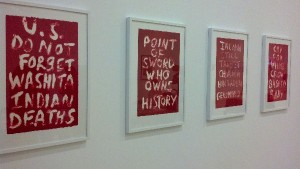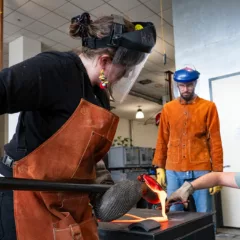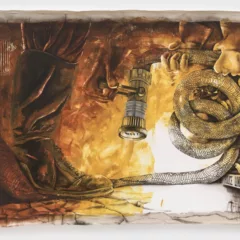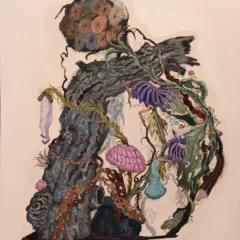This past Thursday, Tyler School of Art alum, Edgar Heap of Birds (b.1954) presented a fascinating lecture about art and life to a huge crowd in Temple Contemporary Gallery. An internationally recognized artist, Heap of Birds’ conceptual art employs text, abstraction, and installation to reference his Native American identity and culture, or other global indigenous cultures. Heap of Birds is a professor of art and Native American Studies at the University of Oklahoma. He has travelled widely to teach, live, and make work about the stories and lives of people whose cultures have been forcibly erased. Part of his practice in this regard involves immersing himself in, as he says, “the local,” the “fish, petroglyphs,” then working his way up “to cultural institutions.” He notes that by doing this he can experience firsthand the original work and life of a certain place and then, “I’m guided to make what I make.”
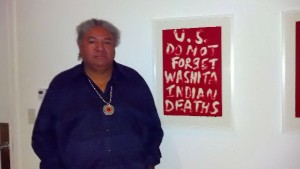
His fifty-page CV is a testament to his great success but also to his ideas about art making which, he notes, is intertwined with life and living; or, as he describes himself: “I’m just a soldier, and I just keep on working.” The artist noted how art school is only a small portion of what may lead to success, saying: “Art school – I don’t know if it even counts.” He stressed that what may be more crucial to success as an artist is “the other 90%…when you care enough to contribute to the world around you.” But it was his art school that welcomed him back to deliver this talk at the same time that his large lithograph, “Telling Many Magpies, Telling Black Wolf, Telling Hachivi,” a work he made as a visiting artist at the Brandywine Workshop, is currently on view in the Full Spectrum exhibition at the Philadelphia Museum of Art. He noted that one of the most important aspects of his graduate education was the visiting artists who were invited to speak and critique student work. He cites a visit from Vito Acconci as being particularly important to him.
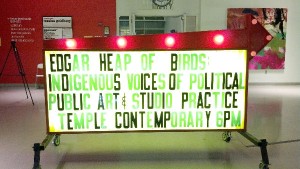
Heap of Birds is known for text-based, public installations, and said that he began using text while still a student at Tyler. Much of these works resemble public signage and use the same industrial materials and installation techniques found in traffic signs, for example. This way of working allows him to capitalize on the idea that people actually read signs, believe what they say, and follow their direction. But his works are “interventions” which often point out the genocidal practices inflicted upon indigenous cultures, or describe the tribes which once lived in a certain area. Reading Heap of Birds’ signs, then, is a jolting reminder of the brutal history that continues to shape our understandings and knowledge about indigenous lives. These are bold works and he describes ‘boldness’ as an important attribute in his art and in his role as a leader of the Elk Warrior Society of his Cheyenne Tribe. The artist noted that in 1988, when his early text-based works were installed in NY, using text allowed him to focus on subject and narrative at a time when “people were trying to be evasive about content. I put the text on there so that they wouldn’t focus on the thickness of my paint.”
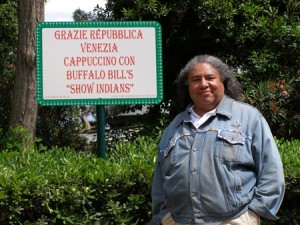
Heap of Birds presented “Most Serene Republics,” at the 2007 Venice biennale. This project included a group of 16 publicly installed signs and 8 individual cemetery signs which honored Native American performers who died in Europe while on tour with the Buffalo Bill Wild West Show in the late 19th century. His project was inspired by people such as Lone Wolf, a warrior and performer who died and was buried in London. Lone Wolf and other men from the Pine Ridge, Sioux reservation were incarcerated at Fort Sheridan when Bill Cody coerced them with the ‘choice’ to either perform or remain in prison. The Sioux nation exhumed Lone Wolf’s body and found three bodies in the grave- two adults and one child. In total, 20 warriors and 3 children are thought to have died during these European tours and Heap of Birds’ project memorializes their lives and families. The project also evinces the deep research that informs his work; research was also an important part of his grad school education, the artist noted. Heap of Birds tells the stories that many of us don’t learn in school.
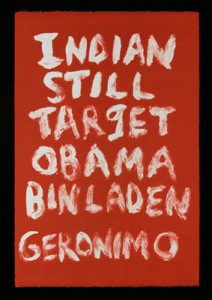
The prints on view at Temple Contemporary Gallery point to more current events that continue to present Native Americans as enemies, such as Indian Still Target Obama Bin Laden Geronimo, which references the covert military operation which killed the U.S.’s number one enemy who was given the code name of Geronimo, the famous Apache leader. The frustration and anger about this conflation of ‘enemy’ with Native American people was palpable when the artist described this project, which in many ways exemplifies his calling as an artist. He said: “When they’re all informed about the Indian world, I’ll stop…which means I’m never going to stop.”
